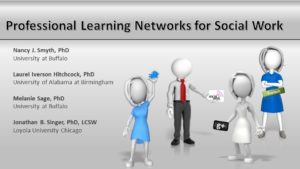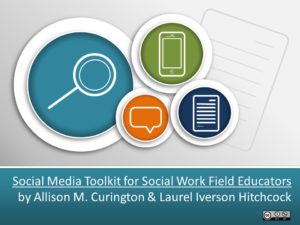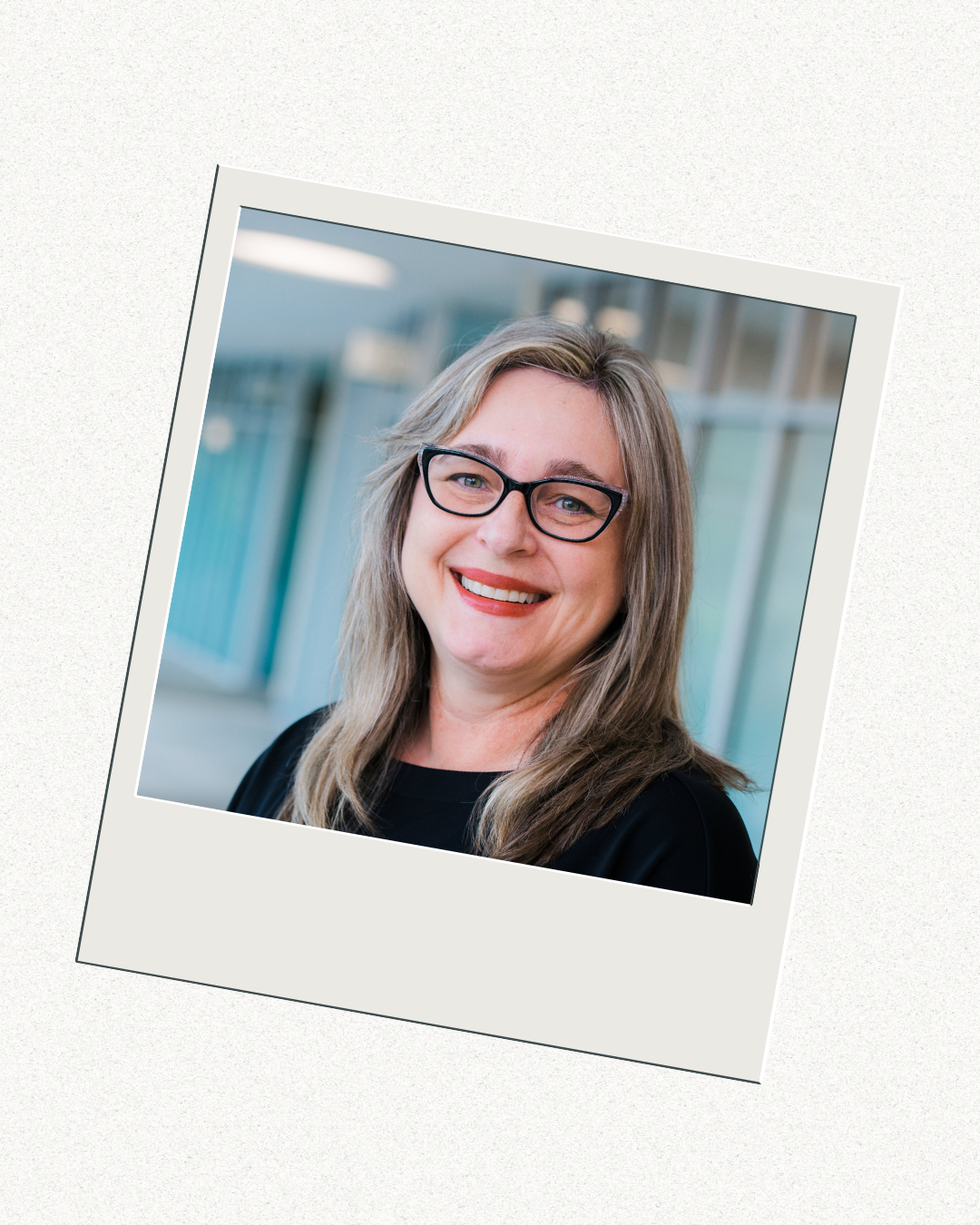#APM17 – Harnessing Technology for one’s own Good: Professional Learning Networks in Social Work
 On 10/22/17, the last day of CSWE’s 2017 Annual Program Meeting, at 10:00 AM in the Dallas Ballroom A-2, Nancy J. Smyth, Melanie Sage, Jonathan Singer, and I are presenting about how social work educators can use technology for career-long learning. Nancy, Melanie and I introduced the idea of professional learning networks (PLN) to a packed room at Social Work Distance Education Conference in April, and wanted to bring the practice to the #APM17 crowd. A PLN incorporates technology-based tools and processes in a way that allows individuals to stay up-to-date and share information about current news, practice knowledge and current research findings. We will be talking about the mechanics, advantages and disadvantages of establishing a PLN. One resources we will be sharing is our Professional Learning Network (PLN) Worksheet, which takes a social worker through the steps of creating their own PLN. You can get your own copy here: https://drive.google.com/file/d/0ByR_E-iQH7PdT2t1WV9YYnlZV00/view?usp=sharing
On 10/22/17, the last day of CSWE’s 2017 Annual Program Meeting, at 10:00 AM in the Dallas Ballroom A-2, Nancy J. Smyth, Melanie Sage, Jonathan Singer, and I are presenting about how social work educators can use technology for career-long learning. Nancy, Melanie and I introduced the idea of professional learning networks (PLN) to a packed room at Social Work Distance Education Conference in April, and wanted to bring the practice to the #APM17 crowd. A PLN incorporates technology-based tools and processes in a way that allows individuals to stay up-to-date and share information about current news, practice knowledge and current research findings. We will be talking about the mechanics, advantages and disadvantages of establishing a PLN. One resources we will be sharing is our Professional Learning Network (PLN) Worksheet, which takes a social worker through the steps of creating their own PLN. You can get your own copy here: https://drive.google.com/file/d/0ByR_E-iQH7PdT2t1WV9YYnlZV00/view?usp=sharing
You can access a copy of the presentation slides here: https://www.slideshare.net/laurelhitchcock/professional-learning-networks-for-social-work-81048022
Using Technology for Productivity: Managing the Academic Workload
This post was written and edited by Nancy J. Smyth, Melanie Sage, and myself as part of our collaboration on our forthcoming book, Teaching Social Work with Digital Technology, to be published by CSWE Press in 2018.
Today’s academic work environments are fast-paced and rely on digital technologies to handle the flow of communication and information such as email, digital calendars, and electronic to-do lists. In this blog post, we asked social work educators and practitioners to share their best tips for using technology as a tool for productivity.
Managing email can be a difficult and time-consuming task. Andy Berkhout, the Data Quality Coordinator from the St. Patrick Center in St. Louis, MO shares his guidelines for managing email:
Clients and colleagues will notice if you are paying more attention to checking email on your phone than you are to them. Instead, set a dedicated time at the beginning or end of the workday to catch up on electronic communication. When it is time to pay attention to the person in front of you, do just that; put your phone away and give your complete focus. Your text messages and email will be still be there later, but the chance to connect with a client or provide meaningful input during a meeting might pass if you’re not giving the present moment your full attention (A. Berkhout, personal communication, September 6, 2017).
Shelly Richardson, an Assistant Professor and Director of Undergraduate Social Work at The College of St. Scholastica in Duluth, MN, uses her prior practice experience to cope with her email:
In my role as an associate professor and director of an undergraduate program, I only check emails twice a day and spend no more than 45 minutes doing so. This forces me to prioritize activities and responses quickly. I only “touch” things once. If I need to take care of something or respond, I do it immediately upon receiving the request. I also have files with names of my frequent contacts (such as co-workers, dean, chair) emails that are initiated by those individuals are easier to find. I also use folder titles for activities I am responsible for (advising, to be graded, coordinating, and committees). These folders allow me to clean up my inbox as I read through emails, I flag emails that are in progress or I need to follow up on and review the flags once a week (usually Monday or Friday). These flagged items stay in my inbox and I work to keep this number around 15-. I also have a rule, if I have to respond more than twice, I make a phone call immediately or schedule a face to face to follow up, this is usually indication that communication has broken down somewhere and needs to be resolved (S. Richardson, personal communication, September 20, 2017).
Harnessing Technology for Social Work Scholarship: #CSWResearch Day at Ohio State University
The blog post was written by myself and Melanie Sage of the University at Buffalo, and we describe our visit with the College of Social Work at the Ohio State University in August 2017, where we talked about how social work faculty can harness technology for their social work scholarship. We also interviewed two of our OSU colleagues, Drs. Bridget Freisthler and Holly Dabelko-Schoeny, about our presentation and how it supports their use of technology for scholarship. This is cross-posted at the Human Services Information Technology Association’s (HusITa) Blog: http://www.husita.org/harnessing-social-media-for-social-work-research-and-scholarship/.
Dissemination to the right stakeholders is a crucial part of social work research. However, as social work academics, we are often trained to think that publication in peer-reviewed journals is the pinnacle of sharing our research with our peers and the academy. But for our work to have substantial impact, we want it to reach service providers, communities, and consumers, too. Access to peer-reviewed journals can be challenging due to cost,availability, and complexity. Increasingly, academics and research scientists are turning to social media platforms as a way to disseminate and engage with others about their work.
One of the early studies looking at the value of social media in research dissemination was an article by Darling, Shiffman, Côté, and Drew (2013) titled The role of twitter in the life cycle of a scientific publication. Based on a survey of 116 marine biologists, they found that scientists who used Twitter for professional reasons could rapidly develop new research ideas and easily share works-in-progress for pre-reviews. Additionally, these researchers found they could communicate their findings not only with other academics, but also with broader audiences such as decision makers, journalists and the public in a way that could amplify the scientific and social impact of publications, and that sharing in this way increased their citations too. Here is an infographic of the article’s major findings.
So how does this translate to social work research? Melanie Sage and I present to multiple audiences, from peers to conference attendees, about the role of social media in social work scholarship. For years, we have been using social media and technology tools to connect with colleagues, share research, and collaborate. Based on our expertise in this area, we were invited to lead a discussion about the role of technology in social work scholarship at the Social Work’s Grand Challenge Initiative Conference (#GC4SW) held at the University of Southern California (April 25-28, 2017). In this discussion, we shared the ways in which social media can be a tool to help social work academics and practitioners to discover and share knowledge, as well as build relationships for collaborative work. Social media platforms are well-placed to allow social workers across the professional continuum to engage with each other, creating communities of learning and practice that bridge the gap between practice and research in social work. We suggested four practices with social media for advancing the Grand Challenges for Social Work; you can read about them here.
Modeling Social Justice through Innovative, Low-Cost Textbook Options for Social Work Students
Both Dr. Victoria Venable and Dr. Becky Anthony (@becky_anthony) and are assistant professors in the Department of Social Work at Salisbury University. In this blog post, they write about designing and self-publishing a course workbook for a generalist level basic interviewing skills practice course. They also share results from a pilot evaluation the workbook and supplemental materials.
The cost of textbooks is problematic for many students at American colleges and universities. College textbook prices have increased by 82% from 2003 to 2013 (Bureau of Labor Statistics, 2014). This economic injustice causes students to miss out on educational opportunities because they have to prioritize paying for their basic needs over textbooks. According to a 2014 study, over 65% of students reported they did not buy a textbook because the cost was too high (Student PIRGs, 2014). If students are not purchasing the book, they cannot read for class – this revelation caused us to brainstorm creative ways to engage students by lowering the cost of textbooks, in hopes of increasing their reading. As social workers, the NASW Code of Ethics asks us to challenge social injustices. We viewed the price of textbooks as a social injustice and explored options that would allow our students to better participate in their learning experience.
Using Technology for Life-Long Learning in Social Work: Professional Learning Networks
This post was written and edited by Nancy J. Smyth, Melanie Sage, and myself as part of our collaboration on our forthcoming book, Teaching Social Work with Digital Technology, to be published by CSWE Press in 2018.
Professional Learning Networks (PLN) exist when social workers use social media to collect information related to professional interests, share this information with others, and collaborate with others on projects (Richardson & Mancebelli, 2011). For more details about PLN, please see this blog post titled Personal Learning Networks for Social Workers (Hitchcock, 2015). A PLN is unique to each person, and learning how others structure their PLN can be helpful in setting up your own network. In this blog post, we asked two social work educators to share their best tips for using technology as a tool for learning.
Kelly Joplin, an Assistant Professor and Director of Field Education from the Carver School of Social Work at Campbellsville University, uses a productivity app called Evernote to support her personal learning network (PLN). She writes:
I love Evernote! It keeps me organized. It has folders where I collect articles, videos, audio clips, pdfs, maps, and links to resources for each of my classes. I use many different types of media in my classes and this makes pulling those different pieces onto the classroom screen seamless. I do not have to toggle back and forth between apps or the internet therefore eliminating the uncomfortable classroom lag time while bringing up media. (I find I lose students in the lag.)
Social Media Toolkit for Social Work Field Educators – Get your Free Copy!
 We are pleased to announce the availability of the Social Media Toolkit for Social Work Field Educators. This toolkit provides Field and other Social Work Educators with tools and resources to help social work students and field instructors assess, develop, and maintain an online identity for professional purposes. There are two parts to the toolkit – an Educator’s Guide and a PowerPoint Slide Deck. The Educator’s Guide provides directions, descriptions, and handouts related to the content of the toolkit while the Slide Deck includes pre-formatted slides with selected content for presenting n the classroom or a workshop. Content in this toolkit can be easily adapted to agency-level continuing education.
We are pleased to announce the availability of the Social Media Toolkit for Social Work Field Educators. This toolkit provides Field and other Social Work Educators with tools and resources to help social work students and field instructors assess, develop, and maintain an online identity for professional purposes. There are two parts to the toolkit – an Educator’s Guide and a PowerPoint Slide Deck. The Educator’s Guide provides directions, descriptions, and handouts related to the content of the toolkit while the Slide Deck includes pre-formatted slides with selected content for presenting n the classroom or a workshop. Content in this toolkit can be easily adapted to agency-level continuing education.
The content of this toolkit is divided into five different topics centered on how to use social media professionally as a social worker:
– Reflecting on Social Media Use in Social Work Practice
– Engaging and Self-Assessment with Social Media
– Professional Practice with Social Media
– Case Studies for Students & Field Educators
– Social Media Learning Activities for Field Education




